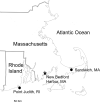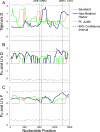Evolutionary and functional analyses of cytochrome P4501A promoter polymorphisms in natural populations
- PMID: 22093087
- PMCID: PMC3232336
- DOI: 10.1111/j.1365-294X.2011.05360.x
Evolutionary and functional analyses of cytochrome P4501A promoter polymorphisms in natural populations
Abstract
The functional importance of variable, transcriptional regulatory sequences within and among natural populations is largely unexplored. We analysed the cytochrome P4501A (CYP1A) promoter in three populations of the minnow, Fundulus heteroclitus, because two SNPs in the promoter and first intron of CYP1A are under selection in populations adapted to pollutants. To define the importance of these SNPs, 1630 bp of the CYP1A promoter and first intron and exon were sequenced in eight individuals from three populations: a population from a polluted environment resistant to some aromatic pollutants and two flanking reference populations. CYP1A is induced by many aromatic pollutants, but in populations adapted to pollutants, CYP1A has been shown to be refractory to induction. We were interested in understanding whether variation in the CYP1A promoter explains mechanism(s) of adaptation to these aromatic pollutants. The CYP1A promoter was extremely variable (an average of 9.3% of the promoter nucleotides varied among all populations) and exhibited no fixed differences between populations. As CYP1A is poorly inducible in adapted fish, we hypothesized that CYP1A promoter regions might vary functionally between populations. Unexpectedly, in vitro analysis showed significantly greater transcription from CYP1A promoters found in the population from the polluted environment relative to promoters found in both reference populations. Thus, despite extensive variation among populations and lack of fixed differences between populations, individuals from a polluted environment have significantly enhanced promoter activity. These data demonstrate that intraspecific variation, which provides the raw material for natural selection to act on, can occur while maintaining promoter function.
© 2011 Blackwell Publishing Ltd.
Figures





Similar articles
-
Cloning and analysis of the CYP1A promoter from the atlantic killifish (Fundulus heteroclitus).Mar Environ Res. 2004 Aug-Dec;58(2-5):119-24. doi: 10.1016/j.marenvres.2004.03.005. Mar Environ Res. 2004. PMID: 15178023
-
Ecologically and evolutionarily important SNPs identified in natural populations.Mol Biol Evol. 2011 Jun;28(6):1817-26. doi: 10.1093/molbev/msr004. Epub 2011 Jan 10. Mol Biol Evol. 2011. PMID: 21220761 Free PMC article.
-
Analysis of CpG methylation in the killifish CYP1A promoter.Comp Biochem Physiol C Toxicol Pharmacol. 2005 Aug;141(4):406-11. doi: 10.1016/j.cbpc.2005.09.009. Epub 2005 Oct 28. Comp Biochem Physiol C Toxicol Pharmacol. 2005. PMID: 16257583
-
Cytochrome P4501A (CYP1A) in teleostean fishes. A review of immunohistochemical studies.Sci Total Environ. 2000 Mar 20;247(2-3):313-32. doi: 10.1016/s0048-9697(99)00500-8. Sci Total Environ. 2000. PMID: 10803558 Review.
-
Evolutionary Physiology and Genomics in the Highly Adaptable Killifish (Fundulus heteroclitus).Compr Physiol. 2020 Mar 12;10(2):637-671. doi: 10.1002/cphy.c190004. Compr Physiol. 2020. PMID: 32163195 Review.
Cited by
-
Evolutionary change driven by metal exposure as revealed by coding SNP genome scan in wild yellow perch (Perca flavescens).Ecotoxicology. 2013 Jul;22(5):938-57. doi: 10.1007/s10646-013-1083-8. Epub 2013 May 31. Ecotoxicology. 2013. PMID: 23722603
-
Genomic and physiological responses to strong selective pressure during late organogenesis: few gene expression changes found despite striking morphological differences.BMC Genomics. 2013 Nov 11;14:779. doi: 10.1186/1471-2164-14-779. BMC Genomics. 2013. PMID: 24215130 Free PMC article.
-
Targeted approach to identify genetic loci associated with evolved dioxin tolerance in Atlantic killifish (Fundulus heteroclitus).BMC Evol Biol. 2014 Jan 14;14(1):7. doi: 10.1186/1471-2148-14-7. BMC Evol Biol. 2014. PMID: 24422627 Free PMC article.
-
Acclimation and acute temperature effects on population differences in oxidative phosphorylation.Am J Physiol Regul Integr Comp Physiol. 2016 Jan 15;310(2):R185-96. doi: 10.1152/ajpregu.00421.2015. Epub 2015 Nov 18. Am J Physiol Regul Integr Comp Physiol. 2016. PMID: 26582639 Free PMC article.
-
Genetic variation at aryl hydrocarbon receptor (AHR) loci in populations of Atlantic killifish (Fundulus heteroclitus) inhabiting polluted and reference habitats.BMC Evol Biol. 2014 Jan 14;14:6. doi: 10.1186/1471-2148-14-6. BMC Evol Biol. 2014. PMID: 24422594 Free PMC article.
References
-
- Adams SM, Lindmeier JB, Duvernell DD. Microsatellite analysis of the phylogeography, Pleistocene history and secondary contact hypotheses for the killifish, Fundulus heteroclitus. Molecular Ecology. 2006;15:1109–1123. - PubMed
-
- Arzuaga X, Calcano W, Elskus A. The DNA de-methylating agent 5-azacytidine does not restore CYP1A induction in PCB resistant Newark Bay killifish (Fundulus heteroclitus) Marine Environmental Research. 2004;58:517–520. - PubMed
Publication types
MeSH terms
Substances
Associated data
- Actions
- Actions
- Actions
- Actions
- Actions
- Actions
- Actions
- Actions
- Actions
- Actions
- Actions
- Actions
- Actions
- Actions
- Actions
- Actions
- Actions
- Actions
- Actions
- Actions
- Actions
- Actions
- Actions
- Actions
- Actions
Grants and funding
LinkOut - more resources
Full Text Sources
Research Materials

